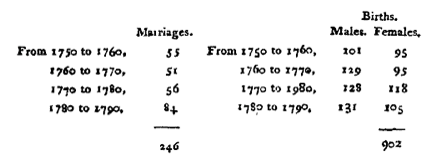The Statistical Accounts of Kincardineshire
At the moment, the only parish I have included is that of (Inver)Bervie where the Raits of Hallgreen lived. Not too much is said about them in the Accounts, but Hallgreen itself is mentioned and we can get a glimpse of what life must have been like for the Raits resident in the area at the time. The Old or First Account is dated 1794. The New Account is dated 1837. I intend to add the parishes of Marykirk and St Cyrus where other Raitts lived – particularly those whose descendants went to Canada, as well as Banchory-Ternan, where my paternal grandmother’s maternal grandfather came from.
**********
PARISH OF INVERBERVIE OR BERVIE.
(County of Kincardine, Synod of Angus and Mearns, Presbytery of Fordoun)
By Mr Walter Thom of Bervie.
Name, Extent, Burgh Of Bervie, &c.
The name seems to be taken from the rivulet of Bervie; with the addition of the Gaelic word Inver, which, in its signification, applies particularly to the situation of the town of Inverbervie, but in common writing and speaking is now in disuse. This parish was formerly a part of that of Kinneff; but as there was no bridge on Bervie water, the minister of Kinneff agreed to keep a suffragan at Bervie, to accommodate the people in that quarter of his parish; and the Lords for the Plantation of Kirks, in the year 1618, disjoined Bervie from Kinneff, and increased the stipends of both incumbents. The power of presentation is vested in the Crown. The extent of this parish is inconsiderable, being only about 2 miles long, and 14½ mile broad; from E. to W. it rises in a gradual ascent, and terminates at the top of a high hill. On the east corner of the parish, the burgh of Bervie is situated; and on the southmost part, the village of Gourdon stands. The burgh of Bervie consists of three streets, which form nearly three sides of a square, and contains about 110 dwelling-houses. The original plan of the town seems to have been laid out in a very judicious manner, but it has not been adhered to; for the houses are set down irregularly, according to the fancy of the builders. Bervie is the only royal burgh in the county of the Mearns, and its charter was granted by David II in the year 1342. When returning from England, he was forced, by stress of weather, to land at the water-mouth of Bervie; and it is said, that having met with great hospitality and kindness from the inhabitants, he bestowed on the town a royalty, as a mark of his particular favour: The place on which he landed, to this day bears his name, and is called Craig David. James VI. in the year 1595, renewed the charter, and confirmed all the privilges and immunities granted by King David. (By this charter, the public property is distinctly marked oat; indeed it comprehends nearly the whole extent of the parish; but the property which now belongs to the town is confined to a piece of barren moor, a few acres of haugh ground, and a range of braes, about a mile in extent, which afford a little graft for the cows belonging to the inhabitants of the town, in the summer season. By this charter, "full power is given, to the free burgesses of the said burgh, and their successors, to make, choose, constitute, and create, a provost, bailies, dean of guild, treasurer, councillors, officers," &c. &c. Accordingly a provost, 3 bailies, dean of guild, treasurer, and 9 councillors, are annually elected, but not by the " free burgesses," as expressed by the charter, in direct language, but by themselves: However, I believe self-election is not confined to Bervie alone, but is the universal practice of the Scotch boroughs. The tradesmen of this burgh have no regular corporations, of course they have no office-bearers as in other towns, but they have a small fund established, by mutual consent, each member pays so much on entry, and quarterly. This money is generally applied in purchasing meal, which they sell out to the members of their own society. Bervie is one of the burghs in the Aberdeen district, and accordingly votes for a representative in Parliament, by a delegate chosen by the town council, and the election takes place in the burghs by rotation of Parliaments.
Fisheries, Manufactures, Markets, &c.—Bervie seems at some period to have been a considerable fishing station, for lines, hooks, and shells, have been dug up in different parts of the town; but beyond the memory of man, there have been no professional fishermen, probably they have removed to the village of Gourdon, which is a more eligible situation for carrying on that business. Bervie has been long famous, or rather infamous, for an illicit and illegal trade in teas, spirits, tobacco, &c.; but the ruinous and baneful trade of smuggling is now much on the decline, being confined to the running (Running, is a phrase which the smugglers in this part of the country use for landing) of a few hundred ankers of spirits annually, and by a set of worthless desperadoes, who do not belong to the town, but bring their goods to Bervie beach, for the sake of conveniency, and an easy landing. In the year 1750, a branch of a sail cloth manufacture was established by a company of merchants of Montrose, and was long carried on with great success, but about 11 years ago was entirely given up; however, the weavers are still, and have long been in the practice of purchasing flax, which they spin, weave, and bleach, each for his own account: The quantity of cloth thus manufactured is inconsiderable, but it finds a ready market in our country-fairs, and generally sells at the rate of 1d. Sterling a-yard, above the current price of cloth of the same quality, whitened at a regular bleachfield. The bleaching of cloth was a considerable trade five or fix years ago, and is still continued, though not to half the extent. About 15 years ago, a manufacture of coloured threads was established in Bervie, and is still carried on. The threads are sent to the London market, where they generally find a. ready sale. This manufacture employs, in all its parts, about 50 people. Three years ago, a machine was erected on the haughs of Bervie, for spinning linen-yarn: This machine was the first of the kind in Scotland. Although exceedingly imperfect at first, it is now brought to a considerable degree of improvement; the yarn it spins is of a good quality, and fit for any sort of manufacture whatever. The proprietors of this machine have also the thread-manufacture, mentioned above, so that all the yarn spun by the machine is made into threads. The house is not yet filled with machinery, but will contain from 600 to 700 spindles, when full, and employ about 60 boys and girls, and 20 or 30 men: and women. Two years ago a sail-cloth manufacture was established, which employs 14 weavers, and a proportional number of other hands. A lint-mill was built last year on the haughs of Bervie, which is likely to meet with encouragement. There are also two mills for cutting barley, and they cut about 1300 bolls yearly, which is generally carried up the frith of Forth. There is likewise a corn-mill, to which the tenants of the parish are thirled. In last December, a distillery was erected in the neighbourhood of the town of Bervie, on a small scale. On the beach of Bervie, there is a salmon-fishing, which yields the proprietors, Viscount Arbuthnot and Mr Barclay of Ury, L.120 Sterling yearly rent. The salmon are of an excellent quality; and when plenty, are ibid at a reasonable price, from 2½d. to 4d. a-pound. Bervie water abounds with trouts and eels, which are caught by the rod in the proper season. In the town of Bervie, there are nine shops, which retail to the town and country around, soft ware, grocery goods, &c. There are five ale houses, for retailing beer, spirits, &c. besides a tavern, which is intended principally for the accommodation of travellers, and the genteel sort of company in the town and neighbourhood. It is to be regretted, that the consumption of spirits is so considerable in this place; it must have a great effect to corrupt and debauch the morals and manners of the people. A weekly market was established about 18 months ago, which is a great conveniency to the inhabitants of the town and neighbourhood, as it affords a regular supply of butchermeat, meal, and every thing else which the country produces. A weekly market was attempted about 30 years ago, but did not succeed, as the demand and consumpt for provisions was not then so considerable as now. The increased consumption of provisions is not owing to any increase of population, but to the extravagance of the labouring people, and the high wages they receive.—Two fairs were held last year on the town's moor, and will be continued annually; the one in May, the other in September: These fairs will be an advantage as well as a conveniency to the inhabitants of the coast-side; for it is in public markets that farmers transact the principal part of their business such as, the buying and selling of cattle, horses, and grain, engaging servants, &c. (A ploughman, capable of sowing, gets from L.8 to L.10 yearly, and his victuals; and a maid-servant, from L.5 to L.6; a boy, from L.2, to L.3; a day-labourer, 1s. a day; a mason, 1s. 8d. a-day; a joiner, 1s. 1d.; a tailor, 8d. and victuals.)
Stipend; School, Poor.—The church was built in the year 1781. The stipend is 4 chalders of victual, 400 merks of money, with L.50 Scots for communion-elements. A process is just now depending for an augmentation. (This account of the stipend was transmitted by the Rev. Mr Croll, minister of the parish.) The manse is a decent house in the town of Bervie, and the glebe about 4½ acres.—The salary of the schoolmaster is 100 merks, and the perquisites of the session-clerkship may amount to L.2, 10s. or L.3—On the whole, his income will not exceed L.18 or L.20 yearly.—The poor are about 12 in general; and all the assistance they get is about L.28 a year, divided among them, which arises from the interest of some money lent out, and the weekly collections at the church-door.
Village of Gourdon.—This village is situated on the south corner of the parish. It consists of 42 habitable houses, besides stables, barns, and granaries. There is a harbour, but it is neither commodious nor safe, being of difficult entry, and much exposed to the violence of the S. E. winds: However, there are eight sloops, or small barks, in all about 300 tons burden, belonging to Gourdon. They are employed in carrying lime and coals to it, and from thence they carry grain occasionally coastwise. They give employment to 24 hands, including the masters: It is only in summer that such small vessels are able to navigate the seas: In winter, they are laid up, and the sailors betake themselves to fishing, at least the most industrious of them do so. There are annually imported into the harbour of Gourdon about 3000 bolls of limeshells; from 700 to 800 bolls of Scots, and about 2000 barrels of English coals, which supply the country for a few miles round. There are about 4000 bolls of grain exported yearly, and which are generally carried to the ports in the frith of Forth, or Glasgow and Greenock, by the canal. About 30 years ago, 50 bolls of Scots coals were sufficient to supply the demand at Gourdon: For many years after that period, the inhabitants were much in the practice of using peats or moss as fuel, but the mosses are now nearly exhausted; and the expence of labour has become so high, that peats are dearer than coals; of course, the demand for coals has very considerably increased within these 10 or 12 years, for coals are the only fuel which is now used in the town of Bervie, and neighbourhood; but the partial and unjust tax on them prevents a greater consumption; it is expensive to the manufacturer, and oppressive to the poor; a tax, which by no means can yield to Government a compensation adequate to its extensive oppression and pernicious effects. Before the year 1768, no lime was imported to be used as a manure; and for a few years after that period, about 2.0 bolls were found sufficient to supply every demand. About 30 years ago, there were 3 fishing-boats, of a large size, besides smaller boats or yauls, which in all employed 30 fishermen; but now there are only 4 small yauls, and 12 men employed in the fishing, and they earn but a scanty pittance, being old and decrepid men, they are unable to work at any other business, and must linger out a miserable existence, with little hope of ever being better; for the fishing-business seems to be much on the decline on this coast, owing to the great scarcity of fishes, particularly of the species called haddocks. Within these 10 or 12 years, the haddocks have left this coast almost entirely. In the year 1782, a prodigious storm happened on this coast, the wind blowing with uncommon violence, raised the sea in such mountainous billows, as to produce effects almost like an earthquake; and since that storm, the haddocks have every year become scarcer. The ground on which the haddocks were found, was a continued bed of mussels, (the favourite food of that fish), clusters of which the fishermen use to draw up frequently with their lines; but since that storm, the bottom has been entirely covered with sand. The mussels being destroyed in this manner, of course it behoved the. haddocks to remove to a more favourable station; however, a few cod-fish are still caught, and they fell at a very extravagant price, at least five or six times the price they were formerly sold for. (Dr Blagden describes the scarcity of haddocks to the effects of electricity. If lightening had destroyed the haddocks, it is wonderful how it should have spared cod-fish, which have been caught in greater abundance since the year 1782 than formerly.) Of late years, a good many herrings have been taken in the proper season, both by the fishermen of Gourdon, and the salmon-fishers of Bervie, which they sell in the neighbourhood at the rate of 3d. a-dozen. Crabs and lobsters are also taken on the coast, and among the rocks.
Country part of the Parish.—There are about 780 acres of arable land here, as much more waste and uncultivated moor, and a few acres of pasture. The low lands are a fine loam of considerable depth, and the high grounds a mixture of clay and gravel. According to the best calculation, there are annually employed in raising turnips 40 acres; pease and beans 30; sown or artificial grasses 200; potatoes 10; wheat 27; flax 5; bear and barley 311; oats 157. There are 6 principal farms; the largest of which does not exceed 144 acres of arable, land, and the smallest not under 25. There are also 12 other tacks or subtacks, the largest of which is 20 acre; and the smallest only 5. There are 1.6 ploughs, 61 horses, and some oxen, employed, in farming; also 16 ploughmen, about 12 maid-servants, 12 boys, and 10 barn-men, besides the farmers, or tenants themselves, some of whom manage or work a plough with their own hands. Within these 12 years, very considerable improvements have taken place, and almost a total alteration in the appearance of the fields, and quality of the soil; the farms being made more compact by excambion, and the fields much improved by liming, manuring, and straighting. The good effects of these improvements are perfectly obvious, from the rise of landrent; for about a third part of the parish, (lying below the high road, and contiguous to the sea-coast), is now let from L.1, 10s. to L.2 the acre, whereas it formerly yielded the proprietor no more than 10s. or 12s. Nor does it appear, that the farmers are now less rich and wealthy than formerly; their manner of living evinces rather the contrary. There are only 2 proprietors in the parish; the Viscount Arbuthnot and Mr Barclay of Ury; the latter of whom is a very spirited and judicious farmer: He was the first who introduced a proper mode of husbandry and culture in this part of the country; he prescribed and laid down to his tenants certain rules for the management of their farms, to which they are obliged to adhere by the tenor of their tacks, by which means he not only increased the value .of his property, but enabled the farmer to live more comfortably and easy. The farmers in general pay part of their rent in grain, which they are obliged to drive to the distance of 12 miles, if necessary. Viscount Arbuthnot's tenants are bound to furnish his Lordship a day's service of their whole reapers annually, and also to drive his coals and peats for family use. Such kind of service is called bondage. During a storm, a considerable quantity of sea-ware is thrown a-shore, which is carried off and laid on the lands, and is esteemed an excellent manure, especially when the crop following is bear or barley;—The real rent of the parish may amount to about L.700 Sterling; the valued rent is exactly L.1815 : 13 : 4 Scots.
Population.—According to the return made to Dr Webster, the population then was 655. The parish at present contains about 985 souls: The town of Bervie, 607: Village of Gourdon, 188: The country part of the parish, 190. (Extract of a letter addressed to Sir John Sinclair, April 26. 1793, by the Rev. Mr Croll. "For a great many years before the present manufactures were established here, the number of catechisable persons, that is, those at or above eight years, amounted to about 400. Since the introduction of the manufactures, that is, in about 15 years and 6 months, the number of catechisable persons is more than 800; and I suppose the number of souls to be about 1000 at least.")
Marriages and Births for 40 Years Past
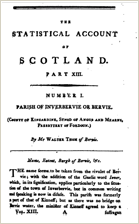
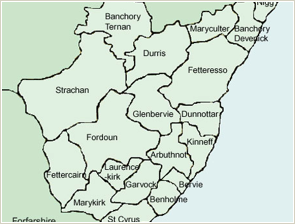
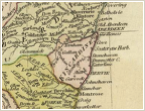
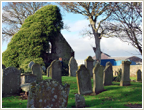
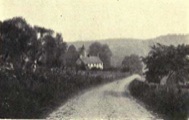
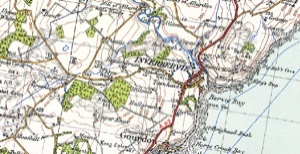
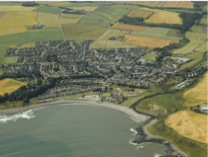
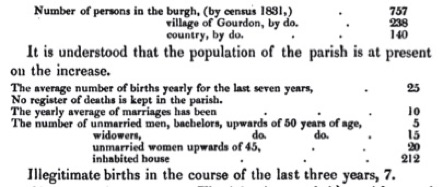
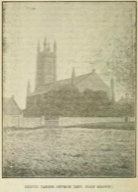

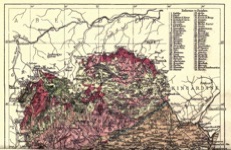
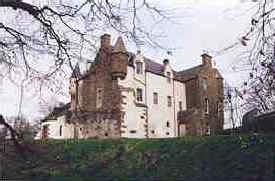
Manufactures.—The duck and dowlas linen weaving is carried on to a considerable extent in the town. It is kept up by merchants in Aberdeen, Dundee, and Arbroath, who employ a good many weavers under the direction of agents.
The men, women, boys, and girls who are employed at the spinning-mills, work twelve hours five days in the week, and on Saturday only nine hours. The mill-master, who now rents both the mills for flax-spinning, had some time ago such a demand for yarn, as to be induced to carry on his work during the whole night as well as the day ; and for that purpose, he engaged spinners for the night work. But while this was found for a time advantageous to the manufacturer in point of profit, it proved peculiarly unfavourable to the health and morals of those employed at the mill, and it was ultimately given up; and no man, who really wishes the spiritual welfare and temporal comfort of his fellow-creatures, can ever desire to see the mills in operation during the hours designed by a gracious Providence for repose and rest.
A sail-cloth manufacture once existed in this parish, and was carried on for a good many years; and a branch of kelp manufacture was also conducted on the beach, near the rocks, successfully, for a considerable time. It was given up a few years ago, when the duty on the barilla was repealed. There was also a bleachfield on the haughs above the bridge, where bleaching formed part of the trade carried on in the parish. This has also been abandoned.
Navigation.—There are but few vessels belonging to the port of Gourdon in this parish. They are not chartered here, but have to clear out at the custom-house in Montrose. There are two shipping companies connected with the place, who generally employ two schooners and three or four sloops in the lime and coal trade. A good many ships come from other ports, bringing coals, lime, pavement, tiles, slates, wood, and occasionally cattle and ponies from Orkney and Shetland; and they leave the port either in ballast or with grain, which at present is the only export trade of the parish of Bervie. The harbour dues are exceedingly moderate.
V.—PAROCHIAL ECONOMY.
Burgh of Inverbervie.—There is no other town in the parish but the burgh, of which the principal trade is the manufacture of linen, commonly called duck and dowlas. The retail trade carried on by merchants for the supply of the inhabitants consists of grocery goods, clothiery, hardware, earthen-ware, &c. A grain market was established here a few years ago, and it has been ever since carried on with the greatest success. It is frequented by corn-merchants from Montrose, Brechin, and Stonehaven; and by farmers and millers from all the neighbouring parishes. It commences about the close of harvest, and holds every Wednesday thereafter for six months. A great deal of business is transacted. As far as can be ascertained, about 40,000 quarters of grain are purchased yearly, and the greater part of it delivered and shipped at Gourdon.
This place has hitherto been well governed by a provost, three bailies, a dean of guild, nine councillors, a treasurer, and clerk. In testimony of which, it may be stated, that the magistrates of this burgh received the unanimous approbation of His Majesty's Commissioners, appointed to examine into the state of the different burghs in Scotland, and were applauded by them for their judicious management of the funds, and the correct state of public accounts. Inverbervie now joins with Montrose, Brechin, Arbroath, and Forfar, in returning a Member to Parliament. By the enactments in the new Municipal Bill, this, as well as other burghs, will experience a great change; and time will only shew its working, either for good or evil. If the successors of the present magistrates, (who will, no doubt, come into office in the course of another year,) strive to imitate their predecessors in that unanimity, fidelity, and zeal for the public good, which have distinguished all their proceedings under the old Burgh Bill, there may be yet hope for the public weal under the new regulations. The present revenue of the burgh is about L.120.
The Fishing Village of Gourdon.—This is the only village in the parish, and it contained, when the census was taken in 1831, a population of 238 souls. It is situated at the southmost point of the parish, and is rather more than a mile distant from the burgh. It is a place rising daily into importance, by the success of the fisheries and the increase of the grain trade. Several large and excellent granaries have been erected in it, during the last eight or ten years, containing extensive sheds on the ground floors for lime, coals, &c. The granaries are capable of holding 4570 quarters grain, the lime sheds, 3200 bolls, and the coal sheds, 12,700 barrels. During the course of the last three or four years, the grain shipped at the port of Gourdon may be computed at nearly 30,000 quarters yearly, two-thirds being barley and bear, and one-third beans, pease, and oats.
There are seven small boats belonging to the village, which are generally employed in the haddock and cod fishery, and manned commonly by six or seven men. There are ten larger boats, which the fishermen employ during the season for herring fishing, and manned, each, by five able bodied men, who go to the herring stations about the middle of July yearly, and continue at the fishing for six weeks or two months. The yearly income of every industrious fisherman in Gourdon may be betwixt L.40 and L.50.
The water, at high-tide, rises 17 feet in the harbour of Gourdon at the point of the quay; and ships, drawing 12 feet water, can enter at low tide, and lie at anchor until it make. It is in contemplation to improve this harbour, which is capable of great improvements. In its present state, eight or nine small vessels can be moored in it; and if the proposed improvements go on, they will be followed by great advantages to the shipping interest, to the inhabitants of the place, and surrounding country.
The quarrying of stones, which for some time past has been carried on a little way to the eastward of the pier, is considered by sea-faring people (if it be continued) as likely to interfere with the protection of the shipping, as the rocks, at the place, are the natural barriers which check the waves from the east, and ought not, on any account, to be removed.
Other means of communication are, the post-office in the burgh, the turnpike road passing direct across the parish, and two daily coaches, viz. the Royal Mail from Aberdeen to Edinburgh, and the Times, from Aberdeen to Perth, which change horses at the head inn near the post-office. These are conveniences which the inhabitants of inland parishes cannot possibly possess to such an extent .
Ecclesiastical State.—The parish church, which has been already noticed in a preceding part of this report, is situated on the north side of the burgh, and is very convenient for the greater part of the people. It is a new building, which was completed in 1836, and seated for 900 persons. There are upwards of fifty free sittings set apart for the poor, besides a seat for baptisms, and pews for the minister, the elders, the schoolmaster, and a choir. The agricultural tenants, by the nature of their leases, have seats free of rent. The feuars and others pay a very low rate for seats, varying from 2s. to 1s. only. The manse underwent a thorough repair about forty years ago, and a small addition was made to it last year.
The extent of the glebe is under five acres (Scotch measure.) It contains very productive land, and if its value were to be calculated by the average rent which small fields bring in the neighbourhood of the town, it may be rated at per acre nearly L.4. The stipend is paid in money and grain by the heritors, out of the parish teinds. The money stipend, including communion elements, is L.41, 5s. 11½d. The grain stipend in bear and meal is 114 bolls, 1 firlot, 2 pecks.
There is a dissenting chapel in the burgh of the Independent persuasion. Its members belonging to this parish do not exceed five. This meeting has been in existence for about thirty years. The members, by collections and seat-rents, make up a sum of about L.25 to the minister, who has from some other sources a small remuneration for his trouble in itinerating and preaching in various parishes during a few weeks in summer. The whole amount of his yearly income may be between L.45 and L.50. He is a very quiet and inoffensive man, and has an earnest desire to do good. Were all ministers of his persuasion of equally peaceful habits, there would be much less discord in many parishes between churchman and dissenter, than what generally prevails. His chapel is generally well filled on Sunday evenings by the members of the Established Church.
Divine service at the parish church is generally well attended. There are a good many persons residing in Gourdon, and in the burgh, who had no accommodation in the old church, and had no desire to dissent. By the habit of non-attendance, they lost, in a great measure, a due sense of the sacred duty of joining in public worship; but they are now happily coming up to the new church, where there is excellent accommodation for all in the parish, who sincerely wish to obey the divine command, and to profit by the public ordinances of the gospel. The number of communicants is about 470, being the average of several years.
The average yearly amount of the collections made in the old church for the poor was L.30. An yearly collection, varying from L.4 to L.5, is made for the Aberdeen Infirmary, and occasional collections are made for religious purposes, such as the General Assembly's schemes, &c.
Education.—There are, at present, six schools in the parish, viz. one parochial school, and five private schools unendowed. The branches of education taught at the parish school are, English reading, writing, arithmetic, English grammar, mathematics, Latin and Greek, &c. The teacher is a licentiate of the Church of Scotland. The first private school is also taught by a licensed preacher of the gospel, who has an establishment for boarders, and teaches the same branches of education as those taught at the parochial school. The other private schools are all conducted by females, and they are entirely for beginners learning to read. The salary of the parochial teacher is L.29, 18s. 9d. He has in lieu of garden, L.2, 2s. 9d. The amount of his school fees varies from L.15 to L.20. The rate of fees at the parochial school is as under: English reading, 3s. per quarter; writing, 2s.; English grammar, 5s.; arithmetic, 4s. 6d.; mathematics, 5s.; Latin, 5s.; Greek, 5s. The terms of board and education at the private seminary are, for young gentlemen under ten years of age, L.16 to L.21; under fourteen, L.22 to L.25.
As far as is known, all boys and girls betwixt six and fifteen years of age, and all persons upwards of fifteen, are learning to read or can read, and a great proportion of them can write.
The people in this parish would, no doubt, be more alive to the benefits of education afforded at the parish school, were an endowment to be procured for an assistant, so as to divide the labours between two teachers, the one to take charge of the elementary, and the other the more advanced classes. In such a place as the parish of Bervie, the extension of the school in this way would, unquestionably, be followed by most beneficial results; parents' prejudices would be removed; the teachers, by a full attendance of scholars, would be more encouraged to prosecute their arduous labours, and the interests of education, in every department of useful and religious knowledge, would prosper.
Charitable Institutions.—A Friendly Society was instituted here in 1799, for the benefit of widows and sick members. It has been productive of much good to the parish, by promoting industry, by supplying the wants of its members under sickness and old age, and by affording a small yearly aliment to widows. The number of persons belonging to this society is at present 110. The funds are under the management of a committee of members who meet quarterly. There is an annual meeting of the whole members. The rate of entry-money varies according to age, from 5s., 7s. 6d. 10s., 15s. to 17s. 6d. The yearly rate is 4s. 1d. The present yearly allowance to widows is L.1, 4s.; to superannuated members, L.1, 7s.; sick members receive weekly, 2s. 6d. The funds of this institution have been most judiciously managed; and, although now considerably diminished by the increase of widows, &c. still amount to L.461, 14s. 1d.
In consequence of the unfortunate loss of a boat's crew belonging to Gourdon in January 1815, five widows and thirteen children were left in the most destitute state. A sum of L.240 was raised by subscription in different parishes for their relief. It was placed under the management of persons belonging to Bervie principally, who became responsible to the public for its proper appropriation. A committee was formed, and the money placed in a fund, to be managed to the greatest advantage; and, by a well-regulated distribution, the widows on this fund were kept comfortable till their families grew up. Those of them who survive are at present in independence, and there is a balance in the hands of the treasurer of L.50, to be applied in the time of need.
A Society, called the Benevolent Society of Odd Fellows, was instituted a few years ago, having the same laudable object in view as the Friendly Society. As it is but in infancy, its full benefits cannot yet be known.
There is no savings bank in this parish. The nearest is that of the parish of Kinneff, about two miles and a-half distant from Inverbervie. It is understood to be prospering, and small sums are sent to it from this place.
Parochial Funds.—The average number of persons on the poor's roll is 15; and each receives, monthly, an allowance, varying, according to circumstances, from 8s. to 3s. and 2s. 6d.
There are a good many dependent families and individuals who do not wish to be put on the roll. They accordingly receive from the parochial funds occasional supplies in the time of their need.
The proportion of the fund which arises from church collections is annually about L.30; the interest of legacies is about L.30; and there are occasional donations given by the heritors of the parish and others for immediate distribution, varying from L.50 to L.5. There is not at present a single pauper in the parish that is subjected to the demoralizing practice of begging from door to door. The poor, therefore, belonging to this place, have great reason to be grateful to God for such an ample provision to their temporal wants, and to rest satisfied and contented in their humble sphere under His kind providence. The princely benefaction of L.500, by the will of the late James Farquhar, Esq. of Inverbervie, to the kirk-session for behoof of the poor of the parish; and the gift of L.50 from the late Mrs Croll, to be added to the fund, place the poor (under all ordinary circumstances) beyond the reach of want.
Fairs.—Two fairs are held annually on a common belonging to the town. They were established many years ago. The one always holds in May, on the Thursday before the 19th of that month, and the other on the Thursday before the 19th of September. The first is well attended, and considered an excellent cattle market. The other, in September, is not so favourable for business, as it generally interferes with the harvest . In 1834, the magistrates of Bervie, with the sanction of the heritors of the parish and the neighbourhood, established three additional markets in the burgh, for the feeing of servants, and for the sale of fat and other cattle. They fixed on the Wednesday before the 22d of November as a market for the feeing of servants and the sale of cattle; the Wednesday before Christmas, old style, and the Wednesday before the 13th February, in each year, for the sale of fat and other cattle. To encourage their success, the magistrates agreed to dispense with custom for the first three years. If these markets succeed, they will be of great advantage to many persons, both in town and country.
Inns.—There are two inns in the burgh where good entertainments are furnished on the shortest notice. At the King's Arms, which is the head inn, a post-chaise and gig are kept for hiring. There are other smaller inns and ale-houses licensed for retailing spirits, ales, &c. both in the town and the village of Gourdon; and, however respectable the keepers of them may be, it is allowed by all who see the evils of intemperance, that there are too many in this parish, and that the licensing of more than what are necessary, is prejudicial in general to human character in every place.
Fuel.—The fuel used by the inhabitants is English coals brought from Sunderland, and Scotch coals from ports on the Forth to the harbour of Gourdon, and sold at 1s. per barrel when taken from the ship; a little more is demanded, when taken from the sheds. The expense of carriage to the inhabitants charged by the carters is 1½d per barrel.
MISCELLANEOUS OBSERVATIONS.
The present state of this parish, as compared with that which existed at the time of the last Statistical Account, exhibits a variety of improvements, such as the building of the bridge which was then only contemplated, excellent roads, reclaimed land by draining, neat and comfortable new houses, a weekly grain market, and an abundant supply of excellent water, in the town as well as in the village of Gourdon. The system of husbandry is now of the most improved kind. The farmers are all experienced agriculturists; and in a very few years all the improvable land in the parish will be under cropping.
There are three extensive farms in the parish of Bervie, Sillyflatt, Hallgreen, and Peattie, on each of which there are four ploughs. There are four (Threewells, Hill-head, Muslepool, and the Innfarm,) on which there is one each. There are two (Newbigging and Dendoldrum) on which there are two. The small farms and crofts are laboured by hiring. There are thrashing-mills driven by water on the largest farms; and the grain on the lesser ones is thrashed by flails.
Rent.—The rent of land varies from L.6 to L.1 per acre.
The boundary line between the burgh and the county, fixed by his Majesty's Commissioners after the passing of the Reform Bill, in 1832, is as follows:—"From the point on the east of the town at which the Bervie Water joins the sea, up the Bervie Water to the point at which the same is met by the boundary of the parish of Arbuthnott, to the point near Dendoldrum, at which the same meets the boundary, which separates the town lands from the property of Mr Farquhar, thence in a straight line to the point at which the several boundaries of the glebe land, the land of the town's muir, and the property of Mr Farquhar meet; thence in a straight line through the south-western corner of the old Castle of Hallgreen to the seashore; thence along the sea-shore to the point first described."
May 1837.
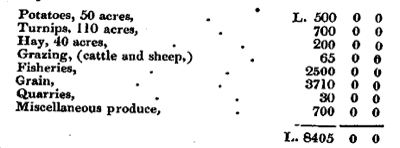
Rent of Land.—The average rent of arable land in the parish is about L.2, 10s. per acre. The rent varies from L.6 to L.1. The rent of grazing, as charged by the burgh, per cow is L.1; and the rent per ewe, as charged by the farmer for hill pasture, is about 6d. each.
Wages.—The general rate of a ploughman's wages (exclusive of two pecks of meal per week, and a pint of milk daily,) is per year about L.12; females, L.4, L.5, and L.6. The wages of outdoor females per day, 7d. The rate of an artisan's labour per day is in summer 2s., and in winter 1s. 6d. The rate for mason-work may vary, per week, from 12s. to 20s. The rate of carpenter work is also various; in general it is about 2s. per day.
Prices of Provisions.—The price of butter per imperial pound varies from 5d. to 10d.; the price of eggs per dozen, from 4d. to 7d.; the price of meal per stone, 1s. 6d. to 2s. 2d; the price of milk per Scotch pint, 2d. to 3d.; cheese per stone, 6s. to 8s.; butcher-meat 4d. to 5½d. per pound.
Live-Stock.—The cattle in the parish are generally of the Angus breed. Those that are reared in it are very fine beasts, but they are but few in number, as the farms are principally grain farms, and are not generally employed in pasturage.
Husbandry.—The husbandry is excellent, and the fields, which are tastefully laid off from one another, produce the most abundant crops of all kinds of grain, such as wheat, beans and peas, oats, barley, potatoes, turnips, &c. and no better mode of farming than that which is presently followed could be devised. Waste land to a considerable extent has been reclaimed, during the last twelve years, by draining, &c.
Leases.—The duration of leases in the parish is nineteen years, with the exception of the burgh lands, which have been for some time past let at no longer a lease than that of ten years. A lease for nineteen years is considered sufficiently favourable, when a farm is entirely improved; but a longer lease would be considered more advantageous to the tenant where much land has to be reclaimed. In this parish, the farmers seem to be well satisfied with the common nineteen years lease.
The farm-buildings are in a state of good order, and are covered for the most part with slates or tiles. The proprietors give every encouragement to their tenants, and have never been known to refuse a reasonable request. The tenants are most respectable and industrious. They have great advantages which those in inland parishes cannot possibly enjoy; such as the genial nature of the climate, the superior quality of the soil, the large supply of sea weed for manure, the grain market established in the burgh, and the shipping port of Gourdon in the parish, where they get lime and coals at little expense, and where they deliver their grain, &c.
Quarries.—There are at present several open quarries of sandstone in the parish, which afford large blocks of excellent materials. They might be turned to good account, if building were to go on extensively in the neighbourhood. The most of the new buildings in this and the neighbouring parishes have been supplied with stones from these quarries. The greater part of the stones for the new parish church was got from them.
Fisheries.— Of these there are several kinds; the salmon, cod and ling, and haddock fisheries. The salmon-fishing is carried on in the bay. The salmon is taken by stake-nets placed in the rocks near the mouth of the water, and by floating nets in the bay; and is acknowledged to be of a superior quality. It is high priced at the commencement of the fishing, and is sent principally to the London market. The fishing begins on the 2d of February, and ends on the 14th of September. It rents yearly at L.130. The price of the salmon when purchased at the fishing station varies from 2s. 6d. to 2s., 1s. 6d., 1s., 10d., 8d., and 6d., per pound, according to the season, the grilse and trout being proportionally cheaper.
The cod and ling fishery is kept up by a fish-curer, who engages a good many of the fishermen in the parish, during the season, and employs an experienced person to dress and salt the cod and ling for the London market. The number prepared for exportation yearly may be about 97 barrels, containing each 3 cwt.; and they are sent to Montrose to be there shipped for London. This fishery commences on the 1st October, and closes on the 15th July. A trade in summer is carried on by the same person in the drying of cod, for home consumption.
The haddock-fishing is also carried on to a considerable extent, and, till lately, the consumption was chiefly home consumption. In the course of last year, a few individuals formed themselves into a company for haddock curing, and made an engagement with the fishermen to supply them daily. They have hitherto been carrying on a very successful trade in dressing, smoking, and barrelling the haddocks for distant markets, such as those of London and Glasgow, where they have found a great demand and ready sale for them; and they are likely to have, at the proper season, sufficient encouragement to enable them to keep up this establishment. This undertaking affords many advantages to the fisher men;—they are saved the trouble of sending the bulk of their fish inland,—they are encouraged to industry by the nature of their engagement with the curers, and by punctual payments on the spot; and besides, there are a good many hands employed at this work, in cleaning, smoking the fish, &c. who get their weekly wages regularly paid. All persons seem to be much interested in the success of this fishery.
A turbot and skate fishery is also actively carried on from 1st May to 15th July, all for home consumption. There are six boats generally engaged.
There was formerly a herring fishery in this parish, which was carried on successfully for several years. The herrings having gone off this coast, the fish-curers were reluctantly obliged to abandon the station. Some of them, however, are again to try it this year; and for that purpose several boats have been engaged for the ensuing season. Success in this fishery would be of vast importance to the place, and a rich source of emolument to all engaged in it.
Produce.—The amount of raw produce, as nearly as can be ascertained, may be as follows:
Character of the People.—The inhabitants of this parish are of cleanly habits in general, and always study to appear in good clothes. They seem to be comfortable and contented, with very few exceptions. The station in which they are placed under Providence does not admit of their devoting much time to the improvement of intellect, or advances in science, but they are, generally speaking, a moral and religious people, who pay a becoming regard to the sanctity of the Sabbath, and to gospel ordinances; and but very few among them have ever been found guilty of grossly transgressing the laws of the land, established for the good order of society. Poaching in game, and in salmon, and smuggling prevailed, it is said, to a considerable extent amongst the people of this parish in former years. But there is now no such thing heard of as smuggling, and the cases of poaching are very rare. The iniquitous practice is sufficiently infamous, of itself, to stamp the mark of shame on every poacher, and no one who has a regard for his character will ever engage in it. It may be mentioned here, as one distinguishing trait in the character of the inhabitants of Bervie, that they are always alive to the calls of humanity, and ready to give aid, according to their circumstances, to alleviate the sufferings of their fellow-creatures. And this is, surely, one grand effect which the gospel has produced, as it is the benign spirit of Christianity which can awaken and keep alive in our hearts a fellow-feeling for the distresses and wants of others.
IV.—INDUSTRY.
There are about 50 persons, including farmers and their male servants, employed in agriculture in this parish.
When the spinning-mill, which is at present under repair, is set a-going, there may be about 14 males, including masters and boys, engaged at both mills.
The number of workmen employed at the dowlas linen weaving, including agents, may be about 112.
There are 8 shopkeepers, 7 shoemakers, 3 tailors, 5 house-carpenters, 5 blacksmiths, 1 cart and plough-wright, 3 masons, 1 watch and clock-maker, 1 cooper, 2 slaters, 1 plasterer, 1 flax-dresser, 1 saddle and harness-maker, 1 boat-builder, being in all 40 masters, who employ occasionally several hands, according to their extent of business. There are also 3 carriers, and several carters, 5 meal sellers, and 2 fleshers.
The number of males employed in the fisheries, as nearly as can be ascertained, is 70.
Agriculture.—
II.—CIVIL HISTORY.
The events worthy of notice connected with this parish are few. The landing of David II. in 1342,—the passing of the Duke of Cumberland in 1745 on his way to the north,—and the gallantry of a small body of volunteers belonging to Bervie, during the French war, may not be uninteresting to readers. King David Bruce, by the violence of a storm, was forced to land at the mouth of the water of Bervie. He met with very kind treatment from the inhabitants, which so gratified and pleased him, that he granted a charter to Bervie, conferring many privileges on its inhabitants. This charter was renewed by James VI. in 1595.
At the time of the Rebellion in 1745, an occurrence took place, which greatly alarmed the inhabitants of this parish, and led the minister, Mr Dow, to use his influence for the protection of their persons and property. Mr Dow, upon learning that the troops under the command of His Royal Highness the Duke of Cumberland could not be restrained from burning the boats of the fishermen, plundering and destroying the neighouring village of Johnshaven, in the parish of Benholme, on account of some of the inhabitants being suspected of sending out provisions in boats to some of the Pretender's troops that were passing by sea, set out on foot to meet His Royal Highness, for the purpose of mediating in behalf of his parishioners. It is said that he met the army, headed by the Royal equipage at the Bridge of Benholme, about three miles from Bervie; that he was taken into the Duke's coach, conveyed to his own door, and honoured with His Royal Highness, as his guest for the night. This interview afforded the minister an opportunity of assuring his distinguished guest, that the inhabitants of Bervie were well affected to His Majesty's government, and it was the means of saving them from the rough treatment of the soldiers, who, otherwise, might have treated them as they did their neighbours in Johnshaven, upon groundless suspicions of disaffection in these disturbed times.
In the year 1800, a French sloop of war appeared one day on the coast of Bervie, and pursued several merchant vessels that were within her reach, till they took shelter in the mouth of the water, and in the port at Gourdon. This privateer would, unquestionably, have made them her prizes; the crew might have landed, destroyed and plundered the town, and carried off a great deal of property; had it not been that the presence and gallantry of a small body of volunteers, belonging to the parish, quite intimidated them. The volunteers were immediately called to arms by the provost of the burgh, Mr Hudson, and marched in two divisions to the beach, to face the enemy. The one party took the one side of the water, and the other went in the direction of the old Castle of Hallgreen. The guns of the privateer were pointed in the direction of those who had gone to the beach, and taken up their position among the rocks, and soon began to discharge their balls in all directions among them, but happily without doing any mischief. Several rounds of musketry were fired by the volunteers, till the crew of the privateer began to suspect, that a heavy fire was about to be opened upon them by the party who had gone in the direction of the Castle of Hallgreen, whom they believed to be a body of artillerymen belonging to that castle, which commands the bay, and has much the appearance of a fort. But, be this as it may, it is related by those who were among the volunteers on that occasion, that no sooner were they seen marching to the heights near the castle, than the ship-of-war put up all sail, and hastened out of sight.
Plans and surveys of this parish are in the possession of the proprietors, or their factors and surveyors.
Land-owners.—The chief land-owners are, the Viscount of Arbuthnott, and James Farquhar, Esq.
Parochial Registers.—The parochial registers, which are in a state of good preservation, have no earlier entries than in 1742 in the Book of Discipline, and 1766 in the Cash-book. There were lately found among some old papers, session records with entries in 1657, but they are so mutilated as scarcely to be legible. The books which contain the present records of the session are two volumes,—the one with the cash entries and distributions for behoof of the poor, and the other containing the minutes connected with the usual business of the session, and the registers of marriages and baptisms. These books are very accurately kept by Mr Paterson, the schoolmaster of the parish, who is session-clerk.
Antiquities.—There is a market-cross in the burgh near the town-house. It consists of a column of stone about 14 feet high, with a ball on the top of it, and it is surrounded at the base by a flight of steps. It is apparently of considerable antiquity. There had formerly been a religious house here, belonging to a body of friars, as there are in the possession of the feuars, charters, with such words as Friars Dubbs, &c.
The discovery of graves by the workmen employed, when the turnpike road was in making, is a further evidence of the existence of such an establishment, for it was near the place still known by the name of Friars Dubbs; and it is conjectured that these graves mark the spot where the friars had their burying-ground.
There are on the top of a hill, in this parish, three circles of earth and stone near one another, which are evidently of antiquity. It would be vain to speculate about the purpose for which they may have been originally formed. It may have been for religious ceremonies, or, what is more likely, these circles may be the vestiges of a Roman camp.
The old Castle of Hallgreen is situated at the southmost point of the Parliamentary boundary of the burgh, on an eminence near the sea, and is a large building. A date appears on the west front of it, considerably effaced, but supposed to be 1376. Its walls are very thick, and full of arrow-holes, and the stones in many parts appear much worn by the lapse of ages. There is every appearance of its having been surrounded by a moat, over which there had been a drawbridge with a portcullis near the outer gate of the court. Several additions appear to have been made to this castle at different periods. Above a door in the court, there is the date 1687, with the initials of a proprietor, Mr Raitt, who then occupied this mansion, and had made a considerable addition to it; and there is in one of the principal rooms, on the stucco-ceiling, a coat-of-arms, with the words spero meliora, and the date 1683. There are also some paintings on the old wainscots which lines the walls, which look like Dutch paintings, viz. two landscapes and a flower-piece. The modern part of this building is habitable, and is presently occupied by a family.
It may not be improper to notice here some other evidences of the antiquity and consequence of the burgh of Inverbervie, such as the existence of a spacious mansion, surrounded by a high wall, having an arched gateway, in front, of fine workmanship. This edifice, it is said, originally belonged to the Marischal family, and latterly became the property and was the town residence of the noble family of Arbuthnott. No part of the building now remains. It was taken down, and the foundation cleared out, about twenty years ago, to make way for feuing and other improvements. There are several other old buildings pointed out as the town residences of the neighbouring lairds. All these circumstances shew that this place had attracted early notice, and had been a favourite place of resort for the gentry.
The town-house is a building of two storeys. There are two dates above the door, the one is 1569, and the other 1720, with the word below it rebuilt. It consists of a hall and small council-room in the upper floor, and the lower contains the flesh and meal-market, to which there is attached a small arched vault, vulgarly called the Black Hole. This place is quite unfit for the regular confinement of prisoners, but is found sometimes very convenient when vagrants become troublesome, and give annoyance to the inhabitants, for they are shut up in it for a few hours by order of the magistrates. There is a handsome belfry on the townhouse, containing a bell, which is rung four times a-day for the benefit of the public, viz. at six and nine o'clock in the morning, at two in the afternoon, and at nine at night.
Modern Buildings.—The new parish church, which was opened for public worship on the 1st of January 1837, is particularly deserving of notice. It is an elegant edifice, built in the Gothic style, with a square tower rising to the height of upwards of 100 feet, and ornamented with carved minarets. The main entrance to the church is by a splendid vestibule in the tower. It is enclosed on the west, north, and east, by substantial walls, built of stone and lime, with a coping of hewn work, and towards the south-east by an elegant metal railing, in which there is a fine gate, with beautiful pillars of hewn work. The small elevation of the building, at a little distance from the street, gives it a fine effect. The tower is seen to great advantage in all directions, and gives an air of ornament and grandeur to the burgh which it had not before. The entire building does great credit to the architect, to the undertaker, and the workmen, and is much admired. It will stand as a monument to perpetuate to future generations the remembrance of the piety and zeal of the heritors of this parish, for the glory of God and the spiritual welfare and comfort of the people.
The manse, which immediately adjoins the church, is a house of two storeys fronting the street, and is sufficiently comfortable and commodious. The school-house, which is situated at the east corner of the town, is a small building of two storeys, commanding a fine view of the sea, but much exposed. The head inn stands at the north-east entrance to the burgh, and commands a fine view of the scenery above the bridge, where the old castle of Allardice, in the parish of Arbuthnott, appears in the distance on an elevation, surrounded with trees and shrubbery.
The bridge thrown across the water at the approach to the town on the north-east is a fine structure, consisting of one beautiful arch of a large span. The height of the bridge from the bed of the river cannot be less than 80 feet. The place fixed on for building it was found to be well adapted for the undertaking, as the banks on either side are high- and composed of rock. Experience has proved the substantial nature of the foundation. The bridge has never been injured by the greatest floods which have happened, while the houses on the haughs have been often damaged, and sometimes in danger of being swept away by the swelling of the water, and the force of the current . If easy access could be got to the doors of the large apartments at the end of this bridge, they might be converted to some useful purpose. They have occasionally been used as coal-sheds, but they are at present quite empty.
There is a meal and barley mill on the haugh below the bridge, and beside it a small spinning-mill. There is, on the upper side of the bridge, a spinning-mill of three stories, which was the first that was established in Scotland for the spinning of yarn and thread. This mill is at present undergoing a thorough repair, and considerable additions are making to it, and, when completed, it will employ a good many more additional hands. All the machinery at these mills is moved by water.
III.—POPULATION.
This parish was originally a part of that of Kinneff. It was separated from it about the time of the Reformation, when the Lords of the Congregation were deeply interesting themselves in the plantation of kirks, and in securing the Protestant worship throughout Scotland, after Presbyterian church government had been established by an act of Legislature. The early state of the population cannot be distinctly traced. By the Government census taken at different times, it would appear that there has been for some time past a gradual increase. This may be accounted for in a great measure by the introduction of spinning-mills, and the encouragement given to weavers in the establishment of different manufactures, employing a good many hands at the loom for various fabrics, such as linen, canvass, weaving, &c.
**********
PARISH OF BERVIE.
PRESBYTERY OF FORDOUN, SYNOD OF ANGUS AND MEARNS.
THE REV. JOHN GLEGG, MINISTER.
I.—TOPOGRAPHY AND NATURAL HISTORY.
Name.—This parish takes its name from the small river that runs along its north-east boundary; and, according to Chalmers, in his Caledonia, the water of Bervie derives its name from the British Beru to flow, Berw, Berwy, a boiling or ebullition. This etymology corresponds exactly with the character of the stream. A distinction between the name of the parish and the burgh may be marked by the Gaelic word Inver, which indicates the situation of the town by its signification, and ought to be applied to the burgh only.
Extent, &c.—The extent of the parish in length is about 2 miles, and in breadth about 1½. Its figure is quadrilateral. It is bounded towards the south and south-west, by the parish of Benholme; the north-west, by the parish of Garvock; the north and northeast, by the parish of Arbuthnott; the east, by the parish of Kinneff; and its boundary on the south-east is the German Ocean.
Topographical Appearances.—The parish has a gradual ascent from east to west, with two ranges of hill running nearly parallel. There is a considerable extent of flat land towards the south and east boundaries of this parish. There is a small fertile valley along the eastern boundary, through which the water of Bervie runs to the sea. The ground on either side is high, and presents a variety of surface. The extent of the coast is about a mile and a-half, being the breadth of the parish; and it appears rocky, excepting that part of it immediately opposite the town. The rocks are not high, being nearly all covered at high water. It would seem that the sea had receded considerably from the high land towards the south-east boundary of the parish, as there are several projecting rocky eminences of considerable height, which evidently appear to have at one time been washed by the ocean. There is a conspicuous land-mark, called Bervie Brow, which is seen by mariners at a great distance. Although it is in the parish of Kinneff, it may be noticed here; and it is also called the rock of Craig David, by the circumstance of that monarch's landing near the spot. The hill called Gourdon Hill, in the parish of Bervie, is also seen by mariners at a great distance.
Meteorology.—The winds that generally prevail are the north and north-east winds in winter; the south and south-east in the spring; the south, south-west, and north-west generally in summer and autumn. The climate is good; and, as a proof of its salubrious nature, it may be mentioned, that there are few prevailing distempers in the district. Influenza, however, has been very severe in this parish during the winter. Twenty persons belonging to the place died of it in the course of a fortnight, and nearly the half of the population were more or less affected, and confined to bed, by the malady. But, as it has been general in town and country throughout Scotland, the prevalence of the disease here cannot be regarded as any proof of the climate's being unfavourable to health in general.
Hydrography.—There are many excellent perennial springs in the parish. The water for the supply of the town, after running so far in a covered drain, is conveyed by leaden pipes to a cistern, and thence to small wells of cast metal in the burgh, which afford the inhabitants a regular supply of the very best water. The only river near the parish is the Water of Bervie, which has its source among the Grampians, in the upper district of the parish of Glenbervie. It has a course of nearly twelve miles, and winds in beautiful curves as it runs on. Its banks, as it passes through the parish of Arbuthnott, are here and there diversified with fine thriving plantations, and enclosed fertile fields and pastures, belonging to the Viscount of Arbuthnott; and it runs into the sea at the eastern extremity of the parish of Bervie. There is also a small burn, the Burn of Peattie, whose water collects about the north-west boundary of the parish, and runs in a short course from west to east into the Water of Bervie. This little stream is found of great service to the tenants who have their farms near it, as it affords a constant supply of water to their cattle.
Geology and Mineralogy.—The soil of the low lands of the parish is deservedly reckoned the most fertile in the county. It is a fine loam of considerable depth, resting on a bed of gravel, easily pervious by water. The gravel is superincumbent on a coarse sandstone conglomerate, and, with the exception of a few patches of trap, provincially called scurdy, this sandstone prevails throughout the whole parish. Where seen exposed, as within flood-mark of the sea, and in one or two sections inland, where it has been quarried for building, it presents alternate layers of rounded blocks of various sizes. In some layers the sandstone produces durable materials for building; and it may be obtained at little expense, and separated into blocks of good size. Within flood-mark one or two veins of trap, of a ferruginous colour, have been observed; but it is not very apparent that these produce much disruption of the beds, or much alteration of the inclination of the strata, which may be stated as generally to north-west, with a dip of 15° or 25°, and having, with slight variation, a direction from south-west to north-east. The veins alluded to are of a porphyritic structure, and not more, at most, than two feet in thickness. Boulders of various sizes, from a foot in diameter to seven feet, are seen within flood-mark; the largest of these is a block of quartz rock. The others are of granite, gneiss, mica slate, &c. These boulders, however, are not numerous, excepting near the village of Gourdon. The beach consists of a considerable mass of small pebbles of jasper, porphyry, slate, agate, &c. Beautiful agates are occasionally found in the loose soil on the higher grounds, as well as on the .beach; and in the Den of Peattie, through which the little stream above alluded to, runs to the water, a large crystal of topaz was found. It is to be observed, that on the highest part of the parish adjoining to Benholme, which forms a hill of perhaps 400 feet and upwards in height, and which rises from the margin of the sea, little soil is to be found, and the puddingstone appears at the summit. The haugh lands adjoining the sea, which had at one time been overflowed by it, are composed entirely of a mass of small pebbles, mixed with black earth: the pebbles form the greatest portion of the mass. These lands are very fertile; rent at about L.5 per acre; and it is said, that if these pebbles were removed, the land would be rendered unproductive.
It may be here observed, that part of the upper fields in the parish is composed of a strong soil upon a clay bottom.
Zoology.—This parish abounds with hares. The birds within it are neither numerous in species, nor rare; a few may be set down as inhabitants or occasional visitors. Horn-owl, screech-owl, common owl, common crow, hooded-crow, rook, jackdaw, magpie song-thrush, blackbird, water-ouzel, stonechat, redbreast, white wagtail, field-lark, several species of titmouse, yellow-hammer, corn-bunting, green-finch, house sparrow, chaffinch, common linnet, window-swallow, black martin, ring-dove (or cushat,) partridge, common heron, corncrake, common snipe, wild duck, cuckoo.
The birds which may be reckoned visitors are sea-fowl in immense numbers, such as gulls, terns, and wild geese, wild swans, (two beautiful white swans were shot a few years ago at the mouth of the river), the starling, curlew, rock-pigeon, woodcock, pheasant, kite or glead, blue hawk, raven, fieldfare, snow-bunting, bullfinch, goldfinch. The water of Bervie is full of fine trout; and salmon frequent it. Crabs and lobsters abound among the rocks near the bay, and shrimps are likewise got among the sands.
In 1826 the beautiful king'sfisher, Alcedo ispida, (the famed halcyon of antiquity), was frequently seen sporting among the rocks at the mouth of the river, its plumage glittering in the sunbeams.
The horses in this parish are of good size, and hardy, and excellent for draught. The cows are excellent milkers; their calves grow large, and readily meet a good market. The fat cattle, which the farmers feed with turnips, bring always good prices. Very few sheep are reared in the parish.
Botany—Among the rare plants in this parish, may be noted the following: Dianthus deltoides, Hordeum murinum and Pulmonaria maritima. All the common seeds of plants and herbs for culinary purposes,—such as cabbages, carrots, brocoli, cauliflower, sallad, lettuce, cress, parsley, spinage, mustard, peas, beans, leeks, onions, raddish; and also some of the sweet and physical herb seeds, such as marjoram, marigold, rosemary, thyme, &c. do well in the gardens. Seeds for agricultural purposes, such as clover, rye-grass, rib-grass, tares, turnip, carrot, &c. thrive well in the fields. And the perennial herbaceous plants, such as primrose, polyanthus, pinks, rocket, rhubarb, sweet William, violet, wallflower, tulips, &c. are seen in the gardens in all their variety of colours. And fruit trees, such as the Keswick codling, Ribston pippin, the moorfowl egg, and Jargonelle pear, the May Duke and blackheart cherry bear well in the little gardens, as well as the rasp and gooseberry bushes, the currants and strawberries.
The more remarkable native plants in the vale of Bervie are
enumerated in the Account of the adjoining parish of Arbuthnott, to which the reader is referred.
The greatest elevation, Bervie Hill, is about 400 feet; but the parish embraces part of the sea coast, and enjoys a temperature superior to that of the inland districts on the same parallel of latitude. In a very warm hollow near Gourdon is found Hordeum murinum. It was seen there in 1824 by Mr Murray, and it is the first locality north of the Forth. The beautiful Pulmonaria maritima abounds on the low stony beach. Various species of Carex, and occasionally several plants from the upland districts, Vicia sylvatica, &c. are brought down by the river floods; Conium maculatum (spotted hemlock) used in medicine, abounds in the rich rank soil of waste corners and lanes of the burgh, although rare in inland country parishes; Carduus tenuiftorus occurs on road sides. The warm arable lands contain the pretty scarlet pimpernel; and Scandix pecten, Saxifraga granulata, Dianthus deltoides, Allium vineale, Eupatorium Cannabinum, Ligusticum Scoticum, Silene maritima, and Bromuspinnatus, are found in the recesses of the rocks on the north bank of the river in Kinneff. Chora vulgaris occurs in some pools; and in the muddy shores of the neighbouring parish of Benholme, Aster Tripolium.
There are some thriving plantations, which consist of ash, elm, beech, birch, firs, (Scotch, silver, spruce, and pine), hazel, oak, larch, &c. The trees are not yet of large size, as it is not many years since they were planted. The ash, oak, and other trees in the dens are doing well. Those that are planted in more exposed situations, and where there is less soil, appear not so vigorous.
Miscellaneous Observations.—By a map of the county, it appears the parish contains exactly 1660 Scots acres, or 2339 English. There once existed in Bervie a religious establishment, of the order of White Friars, but nothing now remains, nor has tradition handed down anything concerning them but the name. Opposite to the town of Bervie, stands the rock of Craig David, in the parish of Kinneff; it is a conspicuous land-mark for mariners, and is seen at the distance of 15 leagues: I mention it here, because it is generally known the name of Bervie Brow. Bervie water is the only river in the parish. It rises in Glenbervie, (about 8 miles from the sea), and meanders in a variety of beautiful curves. A view from the bridge of Bervie towards the house of Allardice, about a mile up the river, affords an agreeable and pleasant prospect, but not remarkably picturesque. By the projection of the rocks on each side of Bervie bay, when an easterly storm sets in, the sea rolls in mountainous billows, and presents a picture truly sublime. The crashing of the waves on the shore is heard at the distance of 10 or 12 miles. The air is wholesome and salubrious, perhaps more so than in several of the inland parishes; but when the wind blows from the east, it is exceedingly sharp, and is the cause of many of the inhabitants being seized with rheumatic complaints, which are every year becoming more prevalent, and generally attack people in the spring or autumn. As a trait of the character of the people of this parish, they are by no means addicted to litigation; are too wise to give their money to lawyers, and neither plague their heads with politics nor religion. There may be one or two Dissenters in the parish, but they are not natives. They live tolerably contented with their situation, no wise engaging in the political squabbles of the present day, perfectly unacquainted with Thomas Paine or Edmund Burke. Tradition hands down a fanciful account of the name of Guthrie in Bervie. When King David came up to Bervie, his servant desired a fisherwoman to gut a fish for the King's supper. “Gut twa”, says his Majesty: "I’ll gut three”, says the woman. “Well”, replies his Majesty; "Gut-three, for ever shalt thou be."--The revenue arising from the town's property, &c. does not exceed L.36 yearly. Were it double or triple the sum, it is to be doubted if it would be applied to any useful purpose, so that the smallness of the revenue is not a matter of much regret. The inhabitants of Bervie have contracted with a man, to bring in water to the town by pipes; the sum necessary to defray the expence, is to be raised by a tax of 1s. on each hearth. It would be of great advantage to Bervie, and the neighbourhood, if a harbour could be got at the water mouth, but the expense must be a great bar to the scheme, and the sea runs so high in a storm, that a small vessel could not easily take the harbour. A new bridge over Bervie water is to be built soon for that purpose: his Majesty has been pleased to give L.1000. Several committees have been held to consider the propriety of establishing turnpikes in this county.
